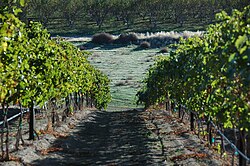| Wine region | |
 Snake River Valley vineyard | |
| Type | American Viticultural Area |
|---|---|
| Year established | 2007[1] |
| Years of wine industry | 160[1] |
| Country | United States |
| Part of | Idaho, Oregon |
| Sub-regions | Eagle Foothills AVA |
| Climate region | Region I; Continental and maritime, semiarid desert[1] |
| Heat units | 1475-1515[1] |
| Precipitation (annual average) | 10–12 in (254–305 mm)[1] |
| Soil conditions | Surface loess, sand, and flood-deposited silt[1] |
| Total area | 8,263 square miles (5,288,320 acres)[1] |
| Size of planted vineyards | 1,800 acres (728 ha)[2] |
| No. of vineyards | 46[1] |
| Grapes produced | Barbera, Cabernet Franc, Cabernet Sauvignon, Canadice, Chardonnay, Cinsault, Gewurztraminer, Grenache, Lemberger, Malbec, Merlot, Mourvedre/Mataro, Petite Sirah, Petit Verdot, Pinot Gris / Grigio, Pinot Noir, Riesling, Roussanne, Semillon, Souzao, Syrah/Shiraz, Tempranillo/Valdepenas, Viognier[2] |
| No. of wineries | 27[2] |
Snake River Valley is Idaho's first American Viticultural Area (AVA) that encompasses an area in southwestern Idaho and two counties in eastern Oregon. The area was established on April 9, 2007 by the Alcohol and Tobacco Tax and Trade Bureau (TTB), Treasury after reviewing the petition submitted by Idahoan vintners of the Snake River Valley, the Idaho Grape Growers and Wine Producers Commission, and the Idaho Department of Commerce and Labor, collectively acting as “petitioner” to establish the 8,263 square miles (5,288,320 acres) viticultural area named "Snake River Valley." For wines to bear the "Snake River Valley" label, at least 85% of the grapes used for production must be grown in the designated area, which includes the southwestern Idaho counties of Ada, Adams, Boise, Canyon, Elmore, Gem, Gooding, Jerome, Owyhee, Payette, Twin Falls, and Washington, and the Eastern Oregon counties of Malheur and Baker.[3] The appellation, when established, was resident to 15 wineries and 46 vineyards with 1,800 acres (728 ha) under vine.[1][2]
- ^ a b c d e f g h i "Establishment of the Snake River Valley Viticultural Area (2005R-463P)" (27 CFR Part 9 [T.D. TTB–59; Re: Notice No. 60] RIN 1513–AB22 Final Rule). Federal Register. 72 (46). Alcohol and Tobacco Tax and Trade Bureau (TTB), Treasury: 10598–10603. March 9, 2007. Archived (PDF) from the original on April 19, 2021.
 This article incorporates text from this source, which is in the public domain.
This article incorporates text from this source, which is in the public domain.
- ^ a b c d "Snake River Valley (AVA): Appellation Profile". Appellation America. 2007. Archived from the original on March 12, 2024.
- ^ "Wine Appellations of Origin" (Requirements for Use). Alcohol and Tobacco Tax and Trade Bureau. Retrieved February 17, 2024.